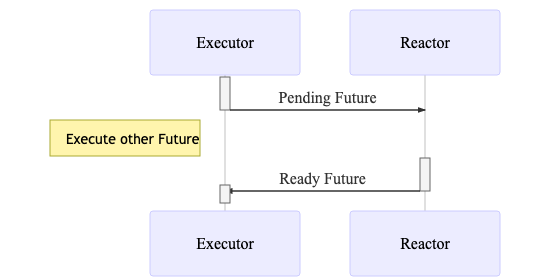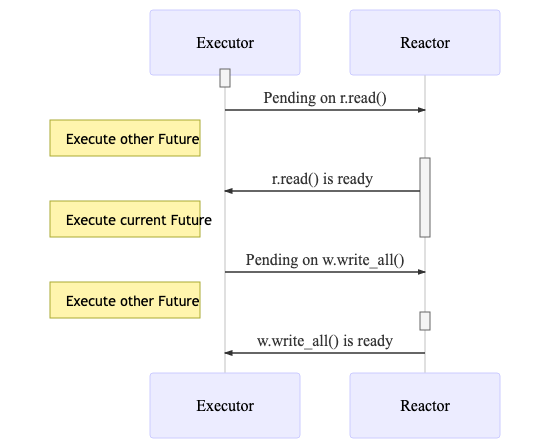这篇文章主要描述了Rust中异步的原理与相关的实现,Rust异步也是在最近的版本(1.39)中才稳定下来。希望可以通过这边文章在提高自己认知的情况下,也可以给读者带来一些解惑。(来自于本人被Rust异步毒打的一些经验之谈).
阅读这篇文章需要对操作系统,IO多路复用,以及一些数据结构有一定的概念。
老生常谈,几乎所有的语言中异步相关的解释都是统一的:线程切换开销大,且资源浪费(主要集中在内存上),这篇文章假定读者已对这些情况已知晓。
Future
Future 字面的意思就是未来发生的事情,在程序中则代表了一系列暂时没有结果的运算子,Future需要程序主动去poll(轮询)才能获取到最终的结果,每一次轮询的结果可能是Ready或者Pending。
当Ready的时候,证明当前Future已完成,代码逻辑可以向下执行;当Pending的时候,代表当前Future并未执行完成,代码不能向下执行,看到这里就要问了,那什么时候才能向下执行呢,这里的关键在于Runtime中的Executor需要不停的去执行Future的poll操作,直至Future返回Ready可以向下执行为止。等等,熟悉Linux的同学可能要说了,怎么感觉和Epoll模型是非常的相似呢,没错,这确实非常相像(但是依然有些许不同,Future可以避免空的轮询),看样子优秀的设计在哪里都可以看到类似的身影。为了实现Rust声称的高性能与零开销抽象,这里做了一些优化,下面一一讲述。
Future结构
1
2
3
4
5
6
7
8
9
10
|
pub enum Poll<T> {
Ready(T),
Pending,
}
pub trait Future {
type Output;
fn poll(self: Pin<&mut Self>, cx: &mut Context<'_>) -> Poll<Self::Output>;
}
|
Future的定义非常简单,Output代表了Future返回的值的类型,而poll方法是执行Future的关键,poll方法可以返回一个Poll类型,Poll类型是一个Enum,包装了Ready和Pending两种状态。
Context
Context提供了对Future进行调度的功能。目前Context作为一个结构体,有一个核心成员Waker,用来唤醒绑定的Future. 未来不排除在Context添加新的字段。
1
2
3
4
5
6
7
8
|
pub struct Context<'a> {
waker: &'a Waker,
// Ensure we future-proof against variance changes by forcing
// the lifetime to be invariant (argument-position lifetimes
// are contravariant while return-position lifetimes are
// covariant).
_marker: PhantomData<fn(&'a ()) -> &'a ()>,
}
|
1
2
3
4
5
6
7
8
9
10
11
12
13
14
15
16
17
18
19
20
21
22
23
24
25
26
27
28
29
30
31
32
|
pub struct Waker {
waker: RawWaker,
}
impl Waker {
/// 唤醒绑定在 Waker 上的数据,通常是 Future
pub fn wake(self) {}
pub fn wake_by_ref(&self) {}
pub fn will_wake(&self, other: &Waker) -> bool {}
pub unsafe fn from_raw(waker: RawWaker) -> Waker {}
}
pub struct RawWaker {
/// A data pointer, which can be used to store arbitrary data as required
/// by the executor. This could be e.g. a type-erased pointer to an `Arc`
/// that is associated with the task.
/// The value of this field gets passed to all functions that are part of
/// the vtable as the first parameter.
data: *const (),
/// Virtual function pointer table that customizes the behavior of this waker.
vtable: &'static RawWakerVTable,
}
/// RawWaker 行为的虚函数表
pub struct RawWakerVTable {
clone: unsafe fn(*const ()) -> RawWaker,
wake: unsafe fn(*const ()),
wake_by_ref: unsafe fn(*const ()),
drop: unsafe fn(*const ()),
}
|
Runtime
Runtime 由两部分组成,Executor和Reactor。
Executor为执行器,没有任何阻塞的等待,循环执行一系列就绪的Future,当Future返回pending的时候,会将Future转移到Reactor上等待进一步的唤醒。
Reactor为反应器(唤醒器),轮询并唤醒挂载的事件,并执行对应的wake方法,通常来说,wake会将Future的状态变更为就绪,同时将Future放到Executor的队列中等待执行。
下面的序列图大概简单的描绘了Future在Executor和Reactor之间来回转移的流程与状态变化。
1
2
3
4
5
6
7
8
9
10
11
12
|
sequenceDiagram
participant Executor
participant Reactor
activate Executor
Executor->>Reactor: Pending Future
deactivate Executor
Note left of Executor: Execute other Future
activate Reactor
Reactor->>Executor: Ready Future
deactivate Reactor
activate Executor
deactivate Executor
|
rust-future
上面说明了一个简单的Future的执行,如果是一个比较复杂的Future的话,比如中间会有多次IO操作的话,那么流程是怎么样的呢?看下面一段代码:(仅仅作为demo,不代表可以直接使用)
1
2
3
4
5
6
|
async fn read_and_write(s: TcpStream) {
let (mut r, mut w) = s.split();
let mut buffer = r.read().await.unwrap();
buffer.append("Hello,world");
w.write_all(buffer.as_bytes()).await.unwrap();
}
|
对应的执行流程为:
1
2
3
4
5
6
7
8
9
10
11
12
13
14
15
16
|
sequenceDiagram
participant Executor
participant Reactor
activate Executor
deactivate Executor
Executor->>Reactor: Pending on r.read()
Note left of Executor: Execute other Future
activate Reactor
Reactor->>Executor: r.read() is ready
Note left of Executor: Execute current Future
deactivate Reactor
Executor->>Reactor: Pending on w.write_all()
Note left of Executor: Execute other Future
activate Reactor
deactivate Reactor
Reactor->>Executor: w.write_all() is ready
|
rust-future-complex
上面的这些例子系统中只展示了一个Future的执行情况,真实的生产环境中,可能有数十万的Future同时在执行,Executor和Reactor的调度模型要更复杂一些。
一句话概括Runtime,Future不能马上返回值的时候,会被交给Reactor,Future的值准备就绪后,调用wake传递给Executor执行,反复执行,直至整个Future返回Ready。
Executor
通常来说,Executor的实现可以是单线程与线程池两个版本,两种实现间各有优劣,单线程少了数据的竞争,但是吞吐量却容易达到瓶颈,线程池的实现可以提高吞吐量,但是却要处理数据的竞争冲突。下面我们以async-std来分析基于线程池的实现:
1
2
3
4
5
6
7
8
9
10
11
12
13
14
15
16
17
18
19
20
21
22
23
24
25
26
27
28
29
30
31
32
33
34
35
36
37
38
39
40
41
42
43
44
45
46
47
48
49
50
51
52
53
54
55
56
57
58
59
60
61
62
63
64
65
66
67
68
69
70
71
72
73
74
75
76
77
78
79
80
81
82
83
84
85
86
87
88
89
90
91
92
93
94
95
96
97
98
99
100
101
102
103
104
105
106
107
108
109
|
/// The state of an executor.
struct Pool {
/// 全局任务队列
injector: Injector<Runnable>,
/// 线程的本地队列,用来进行任务的偷取
stealers: Vec<Stealer<Runnable>>,
/// 存放空闲的线程,用来后续的唤醒并执行任务
sleepers: Sleepers,
}
// 全局的线程池
static POOL: Lazy<Pool> = Lazy::new(|| {
let num_threads = num_cpus::get().max(1);
let mut stealers = Vec::new();
// Spawn worker threads.
for _ in 0..num_threads {
let worker = Worker::new_fifo();
stealers.push(worker.stealer());
let proc = Processor {
worker,
slot: Cell::new(None),
slot_runs: Cell::new(0),
};
thread::Builder::new()
.name("async-std/executor".to_string())
.spawn(|| {
let _ = PROCESSOR.with(|p| p.set(proc));
abort_on_panic(main_loop);
})
.expect("cannot start a thread driving tasks");
}
Pool {
injector: Injector::new(),
stealers,
sleepers: Sleepers::new(),
}
});
/// 工作线程的状态
struct Processor {
/// 本地任务队列
worker: Worker<Runnable>,
/// 存放了比本地队列中任务优先级更高的任务,通常第一次spawn会放到这里,
/// 执行一次poll来快速判断状态,对于无阻塞的任务更高效,不需要等待。
slot: Cell<Option<Runnable>>,
/// How many times in a row tasks have been taked from the slot rather than the queue.
slot_runs: Cell<u32>,
}
fn main_loop() {
loop {
match find_runnable() {
Some(task) => task.run();
None => {
// 实际上,这里根据空循环的次数,会陷入睡眠状态或出让CPU资源,直到新的task来唤醒。
}
}
}
}
fn find_runnable() -> Option<Task> {
// 优先从本地的队列中获取
let task = get_local();
if task.is_some() {
return task;
}
// 其次从全局队列中获取
let task = get_global();
if task.is_some() {
return task;
}
// 最后尝试从其他线程的本地队列中偷取
steal_other()
}
/// 安排新的任务到Executor的执行队列中
pub(crate) fn schedule(task: Runnable) {
PROCESSOR.with(|proc| {
// If the current thread is a worker thread, store it into its task slot or push it into
// its local task queue. Otherwise, push it into the global task queue.
match proc.get() {
// 如果当前线程为worker线程,插入到当前线程的第一优先级任务槽
Some(proc) => {
// Replace the task in the slot.
if let Some(task) = proc.slot.replace(Some(task)) {
// 尝试把任务的优先级提升到最高,并把上一个优先级最高的任务放到当前线程任务队列
// If the slot already contained a task, push it into the local task queue.
proc.worker.push(task);
POOL.sleepers.notify_one();
}
}
// 如果当前线程不是worker线程的话,放到全局队列
None => {
// 将任务放到全局队列中
POOL.injector.push(task);
// 尝试唤醒一个睡眠的worker线程
POOL.sleepers.notify_one();
}
}
})
}
|
这里做了大量的简化,整个Executor是一个线程池,每个线程都在不断的寻找可执行的task,然后执行,然后再找下一个task,再执行,永远重复。
从上面的main_loop中可以看到,cpu并不是一直毫无意义的空转,中间会有一些策略来优化cpu的使用。
Reactor
Reactor作为反应器,上面同时挂载了成千上万个待唤醒的事件, 这里使用了mio统一封装了操作系统的多路复用API。在Linux中使用的是Epoll,在Mac中使用的则是Kqueue,具体的实现在此不多说。
在Future的基础上,出现了AsyncRead/AsyncWrite/AsyncSeek等抽象来描述IO操作,在执行对应的Read/Write/Seek操作时,如果底层的数据尚未准备好,会把所在的Future注册至Reactor。Reactor的流程如下:
1
2
3
4
5
6
7
8
9
10
11
12
13
14
15
|
loop {
poll.poll(&events, timeout);
for event in events.iter() {
if (event.is_readable()) {
for waker in event.readers.wakers {
waker.wake();
}
}
if (event.is_writeable()) {
for waker in event.writers.wakers {
waker.wake();
}
}
}
}
|
Reactor会不断的poll就绪的事件,然后依次唤醒绑定在事件上的waker,waker唤醒的时候会把对应的task移动到Executor的就绪队列上安排执行。
结合Executor的运作原理不难发现,Executor肯定不会poll到未就绪的task,因为只有就绪的任务才会被Reactor放到Executor的执行队列中,Executor的资源利用率再一次被提高,这就是整个异步体系的高明之处。
Stream
Future是异步开发中最基础的概念了,如果说Future代表了一次性的异步值,那么Stream则代表了一系列的异步值。Future是1,Stream是0,1或者N。 签名如下:
1
2
3
4
5
|
pub trait Stream {
type Item;
fn poll_next(self: Pin<&mut Self>, cx: &mut Context<'_>) -> Poll<Option<Self::Item>>;
}
|
Stream对应了同步原语中的Iterator的概念,回忆一下,是不是连签名都是如此的相像呢!
1
2
3
4
5
|
pub trait Iterator {
type Item;
fn next(&mut self) -> Option<Self::Item>;
}
|
Stream用来抽象源源不断的数据源,当然也可以断(当 poll 到 None 的时候)。可以用来抽象 Websocket Connection 读取端,在Websokcet中,服务端源源不断的接受客户端的值并处理,直至客户端断开连接。更进一步的抽象,MQ中的Consumer, Tcp中接收方,都可以看作是一个Stream, 因此Stream的抽象对异步编程意义非凡。
思考: 除了上面的几种情况,还有什么可以抽象成Stream模型呢?
有了代表一次性的异步值Future, 也有了代表可重复的异步值的Stream, 因此,需要有一个代表一次或多次的异步值的通道,也就是接下来的Sink。通常来说, Sink可以来抽象网络连接的写入端,消息队列中的 Producer。
1
2
3
4
5
6
7
8
|
pub trait Sink<Item> {
type Error;
fn poll_ready(self: Pin<&mut Self>, cx: &mut Context<'_>) -> Poll<Result<(), Self::Error>>;
fn start_send(self: Pin<&mut Self>, item: Item) -> Result<(), Self::Error>;
fn poll_flush(self: Pin<&mut Self>, cx: &mut Context<'_>) -> Poll<Result<(), Self::Error>>;
fn poll_close(self: Pin<&mut Self>, cx: &mut Context<'_>) -> Poll<Result<(), Self::Error>>;
}
|
在Sink的上层,我们可以封装 send 以及 send_all 等方法,用来抽象对应的 Future 与 Stream.
Timer
很多情况下,我们希望可以延时执行一些操作,比如定时发送邮件,每隔一段时间生成一次报表。我们首先想到不就是sleep一段时间就行了,下面的代码:
1
2
3
4
5
6
7
8
9
10
|
pub fn get_next_day() -> Time {
thread::sleep(Duration::hour * 24);
current_time()
}
pub fn run_every_hour() {
for thread::sleep(Duration::hour) {
do_something();
}
}
|
是不是很机智呢!😂😂😂! 遗憾的是,我们写完这段代码,提交后,还没上线,估计就要滚蛋了。因此,我们想要的是一个不阻塞当前线程的定时器,定时器到期自动唤醒并执行之后的操作。
不同于Tcp/Udp/Uds,mio没有提供对Timer的封装。
通常来说,对定时器的处理要么是时间轮,要么堆,要么红黑树(时间复杂度更为平均O(log n))。时间轮比较典型的案例就是在Kafka中的使用了,Go Runtime 用的则是堆,红黑树和堆的实现大致相同。
- 时间轮算法可以想象做钟表,每一格存储了到期的定时器,因此时间轮的最小精度为每一格所代表的时间(因此时间轮算法不适合用于对精度要求高的场景)。如果定时器的时间超过时间轮所能表示的时间怎么办呢,也简单,可以通过两种方式来优化。
- 多级时间轮来优化,可以想象,在钟表上,秒针每走一圈,分针走一格,同理分针走一圈,时针走一格,因此多级时间轮中,第一级的时间最为精确,第二级次之,第三级再次之…, 超过某一级时间轮所能表示的事件后,将定时器放到下一级时间轮中。
- 超过时间轮所能表示的时间范围后,对时间取余,插入到余数所在的格子中,这样一来,每个格子中存放的定时器需要加入轮数的记录,用来表明还差多少轮才能执行。每个格子中在插入新的定时器时,可以使用堆来堆定时器进行排序。
- 堆定时器(红黑树定时器)
使用最小堆来维护所有的定时器。一个工作线程不断的从堆里面寻找最近的定时器,如果定时器的时间比当前时间小,则唤醒该定时器对应的task,如果未达到设定的时间,则进行Thread::park(deadline-now)操作,让出当前cpu一段时间。
目前futures-timer的实现为全剧唯一的一个堆。存在可优化空间, 比如 Go 1.14 的实现,把定时器提交到当前worker thread的本地堆里面,用来避免锁竞争,提高性能。
上面定义了实现异步的最基本概念,Future, Stream以及Sink。
但是很多情况下,我们直接使用它们来构建我们的应用是非常困难的,例如:多个互为竞争关系的Future,我们只需其中任意一个Future返回即可,能想到的做法是,我们不断的遍历所有的Future,直到某一个返回Ready:
1
2
3
4
5
6
7
|
loop {
for f in futures {
if f.is_ready() {
return f.output();
}
}
}
|
我们可以把上面的逻辑给包装一下,提供一个名为select!(futures...)的宏,select便可作为一个组合子而存在。类似的组合子还有很多,比如join(futures...),等待所有Future完成。
更多的可以参考futures-util.
Async/Await
上面所有的概念共同组成了Rust的异步生态,那么现在想象一下,如何获取一个Future运行的结果呢。一个可能的做法如下:
1
2
3
4
5
6
|
loop {
match f::poll(cx) {
Poll::Ready(x) => return x;
Poll::Pending => {}
}
}
|
如果每次都要用户这么做的话,将会是多么痛苦的一件事儿呀,还不如用注册回调函数来实现异步呢!
有没有更精炼的方式来获取Future的值呢,这就是async/await出现的原因了。本质上来说,async/await就是上面代码段的一个语法糖,是用户使用起来更加的自然。上面的代码可以替换成:
是不是有非常大的简化呢!
虽然上面提到了各种各样的概念,但是仔细捋一下,便会发现整个异步可以分为三层:
Future/Stream/Sink,Reactor/Executor直接作用于前面的三种类型。此层是为底层,一般用户很少接触,库的开发者接触较多。- 组合子层,为了提供更为复杂的操作,诞生了一系列的异步组合子,使得异步变得更利于使用,用户会使用这些组合子来完成各种各样的逻辑。
async/await,准确的说,这层远没有上面两层来的重要,但是依然不可或缺,这层使得异步的开发变得轻而易举。
注意的地方
- 不要在任何异步函数中执行任何阻塞操作,不仅仅是
thread::sleep, 还有标准库的Tcp/Udp, 以及sync中的channel, Mutex, RWLock 都不应该继续使用,除非你知道你在干什么!替换为async-std 与 futures中实现的版本。
- 如非必要,不要自己尝试去实现
Future,自己实现的没有触发wake操作的话,将永远不会唤醒,取而代之,用已经实现好的Future进行组合。
- 使用
async/await代替所有需要异步等待的点,这将会极大的简化你的代码。



